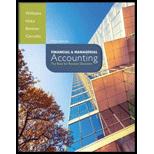
a.
Prepare a schedule showing the estimated increase in annual net income from the planned manufactured and sale of dinosaur toys.
a.
Explanation of Solution
Capital budgeting:
Capital budgeting is a process by which the management can plan and evaluate the investment proposal of plant assets.
Prepare a schedule showing the estimated increase in annual net income from the planned manufactured and sale of dinosaur toys as follows:
| Company T | ||
| Schedule of Estimated Net Income | ||
| Particulars | $ | $ |
| Estimated sales (1) | 480,000 | |
| Less: Estimated incremental costs | ||
| Variable | 200,000 | |
| Fixed manufacturing costs (except | 45,000 | |
| Depreciation expense (3) | 110,000 | |
| Selling and general expenses | 55,000 | 410,000 |
| Income before income taxes | 70,000 | |
| Less: Income taxes expense (4) | 28,000 | |
| Estimated increase in annual net income | 42,000 | |
Table (1)
Therefore, the estimated increase in the annual net income is $42,000.
Working note:
Calculate the amount of estimated sales
Calculate the variable manufacturing cost
Calculate the depreciation expense
Calculate the income tax expense
b.
Ascertain the annual net
b.
Explanation of Solution
Ascertain the annual net cash flows expected from the given project as follows:
| Particulars | $ | $ |
| Cash receipts | 480,000 | |
| Less: cash outlays | ||
| Variable manufacturing costs | 200,000 | |
| Fixed costs (other than depreciation) | 45,000 | |
| Selling and general expenses | 55,000 | |
| Income taxes expense | 28,000 | 328,000 |
| Annual net cash flow from sale of new product | 152,000 |
Table (2)
Therefore, the annual net cash flow from sale of new product is $152,000.
c.
Ascertain the (1) payback period, (2) return on average investment, and (3)
c.
Explanation of Solution
Payback period: Payback period is the expected time period which is required to recover the cost of investment. It is one of the capital investment method used by the management to evaluate the proposal of long-term investment (fixed assets) of the business.
Present value: This is the amount of future value reduced or discounted at a rate of interest till particular current date.
Ascertain the (1) payback period, (2) return on average investment, and (3) net present value, and assume annual discount rate is 15 percent as follows:
(1) Payback period:
When the estimated annual net cash is equal, the cash payback period is calculated as below:
Therefore, the payback period of the equipment is 2.3 years.
(2) Return on average investment:
Therefore, the return on average investment is 22.7%.
(3) Net present value:
| Particulars | $ |
| Total present value of annual net cash flows (5) | 347,016 |
| Add: Present value of salvage, due in three years (6) | 13,160 |
| Total present value | 360,176 |
| Less: Amount to be invested | 350,000 |
| Net present value of the project | 10,176 |
Table (3)
Therefore, the net present value of the project is $10,176.
Working note:
Calculate the present value of cash flow at the end of the 3rd year
| Particulars | Amount ($) |
| Cash flow of the investment (a) | $152,000 |
| PV at $1 annuity at discount rate of 15% for 3 years (b) | 2.283 |
| Present value of cash flow after 3 years | $347,016 |
Table (4)
(5)
Note: The Present value of an ordinary annuity of $1 for 3 years at 15% is 2.283 refer present value table in Exhibit 4).
Calculate the present value of salvage value
| Particulars | Amount ($) |
| Salvage value (a) | $20,000 |
| PV factor at an annual discount rate of 15% for 3rd year (b) | 0.658 |
| Present value of cash flow | $13,160 |
Table (5)
(6)
Note: The present value of $1 for 3rd year at 15% is 0.658 (refer present value table in Exhibit 3).
Want to see more full solutions like this?
Chapter 26 Solutions
Financial & Managerial Accounting
- Hello tutor please provide correct answer general accounting question with correct solution do fastarrow_forwardBurlington Systems estimated manufacturing overhead for the year at$420,000. Manufacturing overhead for the year was overapplied by $12,000. The company applied $390,000 to Work in Process. The amount of actual overhead would have been ____.arrow_forwardCan you explain the correct approach to solve this general accounting question?arrow_forward
- Please explain the solution to this general accounting problem with accurate principles.arrow_forwardCarrington Trading is a merchandising company. Last month, the company's cost of goods sold was $72,800. The company's beginning merchandise inventory was $24,500, and its ending merchandise inventory was $21,300. What was the total amount of the company's merchandise purchases for the month?arrow_forwardPlease provide the answer to this general accounting question using the right approach.arrow_forward

 AccountingAccountingISBN:9781337272094Author:WARREN, Carl S., Reeve, James M., Duchac, Jonathan E.Publisher:Cengage Learning,
AccountingAccountingISBN:9781337272094Author:WARREN, Carl S., Reeve, James M., Duchac, Jonathan E.Publisher:Cengage Learning, Accounting Information SystemsAccountingISBN:9781337619202Author:Hall, James A.Publisher:Cengage Learning,
Accounting Information SystemsAccountingISBN:9781337619202Author:Hall, James A.Publisher:Cengage Learning, Horngren's Cost Accounting: A Managerial Emphasis...AccountingISBN:9780134475585Author:Srikant M. Datar, Madhav V. RajanPublisher:PEARSON
Horngren's Cost Accounting: A Managerial Emphasis...AccountingISBN:9780134475585Author:Srikant M. Datar, Madhav V. RajanPublisher:PEARSON Intermediate AccountingAccountingISBN:9781259722660Author:J. David Spiceland, Mark W. Nelson, Wayne M ThomasPublisher:McGraw-Hill Education
Intermediate AccountingAccountingISBN:9781259722660Author:J. David Spiceland, Mark W. Nelson, Wayne M ThomasPublisher:McGraw-Hill Education Financial and Managerial AccountingAccountingISBN:9781259726705Author:John J Wild, Ken W. Shaw, Barbara Chiappetta Fundamental Accounting PrinciplesPublisher:McGraw-Hill Education
Financial and Managerial AccountingAccountingISBN:9781259726705Author:John J Wild, Ken W. Shaw, Barbara Chiappetta Fundamental Accounting PrinciplesPublisher:McGraw-Hill Education





